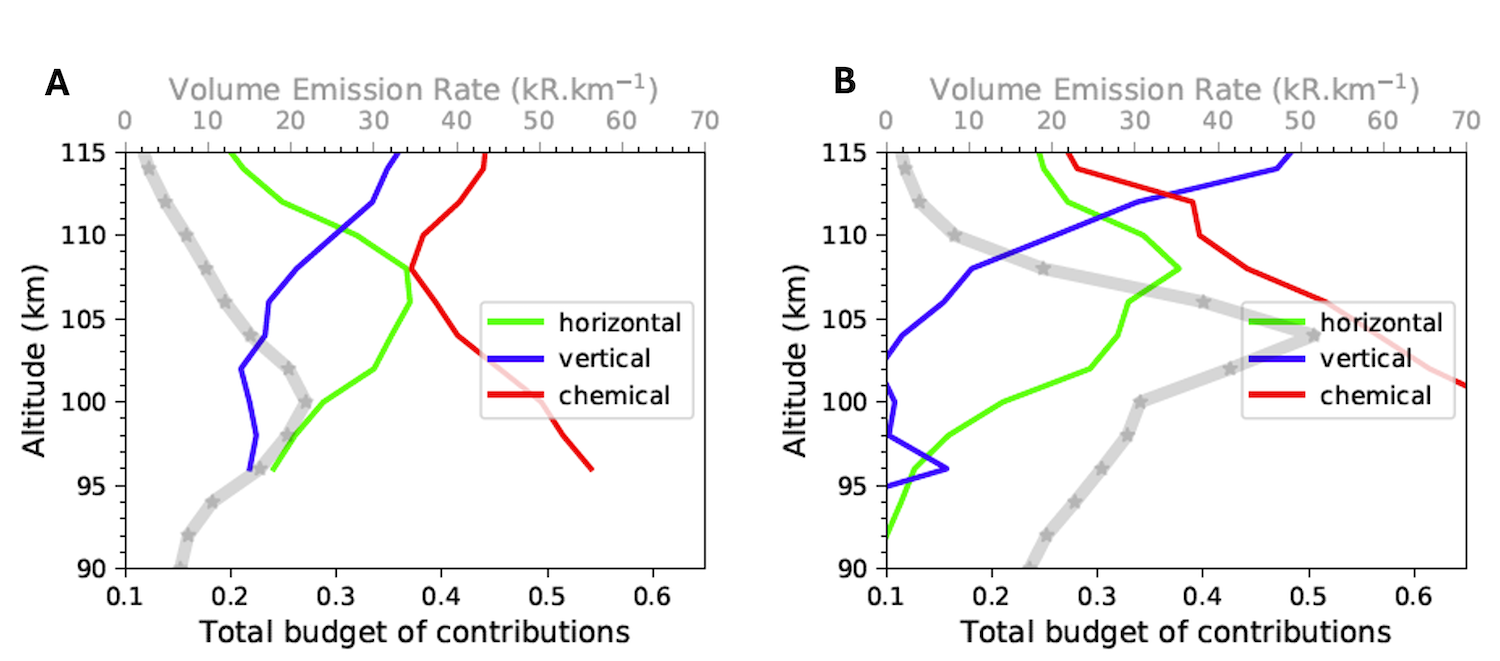A re-analysis of the circulation in the “transition region” of Venus atmosphere (90-130 km) with the Venus PCM
- 1Instituto de Astrofisica de Andalucia (IAA-CSIC), Granada, Spain (gilli@iaa.es)
- 2Space Science Institute, Boulder, Colorado
- 3Laboratoire de Météorologie Dynamique (LMD/IPSL), CNRS, Paris, France
- 4LATMOS, CNRS, Sorbonne Université, Université Versailles St Quentin, Paris, France
Abstract
In this study we use the most recent version of the ground-to-thermosphere VPCM [1] that includes an ionosphere model, ambipolar diffusion and nitrogen chemistry [2]. This tool allows us to investigate and identify in 3D potential mechanisms responsible for the observed variability in Venus’s atmosphere, in the region between 90 km and 130 km altitude. NO and O2(Δg) airglows, are commonly used to shed light on the global dynamics and circulation patterns above 90 km. Their characteristics are a combination of horizontal, vertical transport and chemical net reactions [3,4].
We performed sensitivity tests of unconstrained parameters (e.g. gravity waves drag and eddy diffusion vertical profile) to evaluate the impact on the dynamical structures, O densities, temperature and O2(Δg) nightglow characteristics. These results depict possible scenarios useful to interpret future EnVision observations of trace compounds in those mesosphere layers currently poorly constrained, and not fully explained by current 3D models.
Introduction
Large latitude and day-to-day variations of temperature, composition, and apparent zonal wind velocities were measured by Venus Express [5,6,7] and ground-based telescopes [8,9] in the region between 90 and 130 km altitude. In this atmospheric region two main dynamical flows coexist: the subsolar-to-antisolar circulation (SS-AS) and the retrograde super-rotating zonal wind (RSZ). Those atmosphere levels lack observations and airglow emissions (e.g. O2(Δg) and NO nighttime fluorescence) are commonly used as tracers for studying the dynamical structure due to their peak brightness and horizontal distribution [10]. Unfortunately, many free parameters and theoretical uncertainties (i.e. limited gravity wave constraints for wave breaking, quenching rate coefficient for the IR mesospheric cooling, etc) prevent existing GCMs to converge to a unique set of wind field, eddy diffusion coefficients and wave drag parameters to reproduce observed density, temperature, and airglow variations. In addition, airglow variability is a combination of horizontal transport, vertical transport, chemical reactions and local change of temperature and density. Predictions with the Venus Planet Climate model (V-PCM) [4] showed that contributions from chemical processes and vertical transport often prevail over horizontal transport. Therefore, 1.27 um O2(Δg) nightglow is not necessarily a good dynamical tracer of zonal wind in this region. Those authors also explained the observed variability with the impact of westward propagating Kelvin waves, enhancing the meridional circulation, and periodically transporting molecular oxygen to high latitudes.This highlights the importance of an exhaustive and precise description of oxygen chemistry, which is still a challenge on Venus.
Motivation of this study
Recent V-PCM improvements presented in [1] and [2] focused on Venus’s atmosphere above 130 km, and performed a comprehensive validation of model results with PVO, Magellan and VEX observations in the thermosphere and ionosphere. The outputs of those simulations fed the current version of the Venus Climate Database (see http://www-venus.lmd.jussieu.fr). However, those model developments, together with ad-hoc tuning of parameters (see [1] for details) to fit observational data, changed dramatically the global circulation in the transition region. For instance, we found that this region is very sensitive to the unconstrained parameters used in our gravity wave parameterization (e.g. EP-flux, diffusion coefficient). In addition, there is still large uncertainty on the quenching rates and rate coefficient value used in the main production reaction of O2(Δg) nightglow (O + O + M -> O2(Δg) + M).
This work is a follow-up of [4], where we use an updated version V-PCM as in [1,2] to perform a number of sensitivity tests and provide an exhaustive analysis of the impact on our results (e.g. temperature, circulation, O densities, O2(Δg) nightglow) from unconstrained parameters and theoretical uncertainties (e.g. gravity waves drag, eddy diffusion coefficients, rate coefficients).

Figure1: Example of sensitivity tests performed with the V-PCM using the Volume Emission Rate (VER) of O2(Δg) as proxy. According to [4] (Panel A), the contributions from chemical processes and vertical transport often prevail over horizontal transport. Near the peak of O2(Δg), the chemical contributions account for 50% of the variation, the horizontal transport for 30% and vertical transport for about 20%. With the current version of the V-PCM as in [2,3] (Panel B) the vertical contribution is reduced to 10%, due to the reduced temperature at nighttime by about 40 K (consequently a decreased subsidence) and increased gravity wave drag above 100 km.
Acknowledgements
G.G. and A.M. acknowledge financial support from Junta de Andalucía through the program EMERGIA 2021 (EMC21 00249). AS and LML arefunded by the Spanish MCIU, the AEI and EC-FEDER funds under project PID2021-126365NB-C21. IAA-team also acknowledges financial support from the Severo Ochoa grant CEX2021-001131-S funded by MCIN/AEI/ 10.13039/501100011033.
References
[1] Martinez et al. 2023 Icarus, 2023, 115272, 0019-1035, https://doi.org/10.1016/j.icarus.2022.115272
[2] Martinez et al. 2024, Icarus, 415:116035
[3] Gilli et al. 2021, Icarus, 366:114432, https://doi.org/10.1016/j.icarus.2021.114432
[4] Navarro et al. Icarus, 366:114400, https://doi.org/10.1016/j.icarus.2021.114400
[5] Soret et al.2009, Icarus, 217:849–855
[6] Vandaele et al. 2016, Icarus, 272 (2016), pp. 48-59
[7] Shakun et al. 2023, Solar System Research, Vol.57,n3
[8] Moullet et al. 2012, A&A, 546:A102
[9] Lellouch et al. 1994, Icarus, 110:315–339
[10] Brecht et al. 2011, JGR(Planets), 116 (2011), p. 8004
How to cite: Gilli, G., Martinez, A., Stolzenbach, A., Navarro, T., Lebonnois, S., Lefèvre, F., Streel, N., and Lara, L. M.: A re-analysis of the circulation in the “transition region” of Venus atmosphere (90-130 km) with the Venus PCM, Europlanet Science Congress 2024, Berlin, Germany, 8–13 Sep 2024, EPSC2024-256, https://doi.org/10.5194/epsc2024-256, 2024.